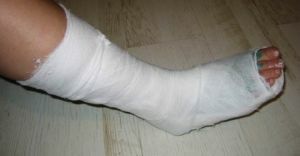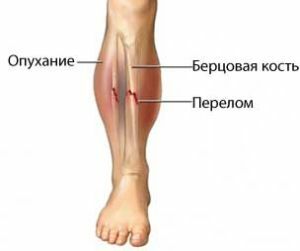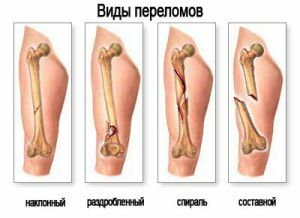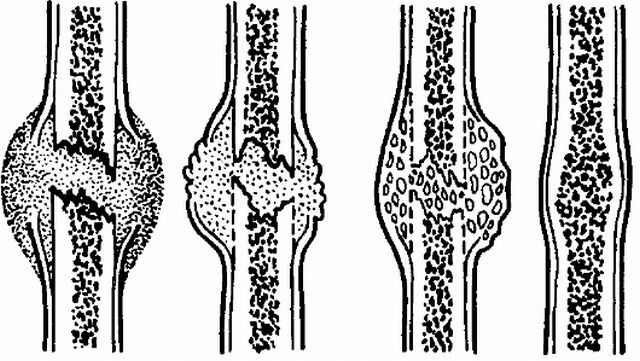 Fracture of the foot is called complete, or partial violation of the integrity of one or more leg bones.
Fracture of the foot is called complete, or partial violation of the integrity of one or more leg bones.
This is a serious injury that requires long treatment and subsequent recovery.
The causes of fractures are divided into three categories:
- result of birth injury;
- result of an accident;
- is due to the course of the disease, which is characterized, in particular, by bone fragility( osteomyelitis, osteoporosis, tuberculosis, etc.).
Typically, a second type of fracture occurs due to various injuries and accidents that occur to people as a result of their activities.
Fractures in young children are less frequent, because their bones are more flexible and mobile than in adults.
In the old age, the amount of fracture can both grow because of the increased fragility of bones, and decrease as a result of the calmer and cautious life that elderly people lead.
Article Contents
- clinical picture
- Varieties injury
- Features femoral fractures
- Trauma shin
- Fractures of the bones of the foot
- First Aid
- injury therapy in a medical institution
- Human Nutrition
clinical picture
leg fracture is diagnosed by such possible symptoms:
- limited leg mobility;
- progressive swelling at the site of injury;
- subcutaneous hemorrhage at the site of injury;

- acute pain when trying to move a damaged leg.
Also feature such reliable signs:
- unnatural bending of the leg;
- crepitation when moving with a foot;
- flexion of the leg in a place where there is no joint;
- skin disruption, bleeding, visible bone fragments( open fracture of the leg).
Variety of injury
Fractures are divided into open and closed.
An open fracture of the leg is a more severe type of injury, characterized by a violation of the external skin, and muscle rupture, bleeding. Closed fracture is easier in this respect, but more difficult to diagnose.
At the location of the fracture of the legs are divided into fractures of the hip, lower leg and foot.
Features of Femur Fractures
Femur is the longest bone in the human body. One end of it is involved in the hip joint, the other in the knee joint.
Therefore, fractures of the femur are divided into fractures of the proximal and hip joints, fractures of the body of the bone, fractures of the distal part of the femur.
Fractures of the upper thigh are more common in the elderly, and in women.
In the elderly, such trauma is due to the fact that the bone tissue of the swollen cavity is thinned with age, and there is enough of an ordinary fall to get a fracture.
Women have a slightly different structure of the pelvic region, and it carries an increased load. In addition, in older women with the onset of menopause, there is often a shortage of calcium in the skeleton, and the bones are more fragile.
Most often there are fractures of the neck, head and base of the neck of the thigh.
The symptom of a fracture of the upper thigh is the swelling of the injured leg, and its wrong position, it is deflected outward, as if the hip joint has failed.
To fractures of the diaphysis of the bone and the distal part of the femur often results in a physical effect of high energy, that is, the result of accidents, fights, falls and other minuses of active lifestyles. 
By type of injury, closed fractures of the diaphysis are divided into:
- straight;
- oblique;
- fragmentation;
- helical;
- with offset.
You can recognize the fracture of the diaphysis by the fact that the leg is shortened, abnormally mobile where there is no joint, is deformed.
Fractures are accompanied by a sharp pain, the inability to stand on the foot.
The distal part of the thigh has two endings - the condyles. Fractures of this part of the leg are intraarticular - fractures of both or some one condyle - and extraarticular.
A common cause of such injuries is an accident, sudden braking causes a knee impact on the dashboard. In the elderly, when the bones are fragile enough, it is enough to fall on the knee for the appearance of a fracture.
With a patella fracture, the knee looks more prominent, fractures are often accompanied by internal bleeding, blood accumulates in the joint bag.
Mobility is limited, sometimes the limb is shortened, and also sharp pain, impossibility of independent movement.
Injury of the lower leg
The tibia and tibia form the shin. Accordingly, both bones can be broken, or one of them.
Localization of such injuries are divided into fractures of the proximal, middle and lower parts of the shin.

Photo of an open fracture of the foot
This includes fractures of bones entering the knee joint, ankle fractures, and ankle fractures.
Common symptoms of such fractures include acute pain, swelling, bruising at the fracture site. The leg is forced to bend at the knee, the shank displacement, swelling under the knee.
If the tibia is broken, no support for the leg is possible. The tibia has a smaller load, it can be slightly supported. Fractures of the ankle are accompanied by a strong edema, the foot is unnaturally turned out, you can not stand on your foot.
Fractures of the foot bones
There are 26 different bones in the foot. The foot takes over the weight of a person, and any violation of its integrity in case of unsuccessful treatment in the future can deprive the person of the opportunity to move comfortably and freely.
Therefore, it is very important to properly treat such an injury. Fractures of the foot occur with unsuccessful jumps from height, with excessive pressure on the foot, or as a result of physical impact.
The foot bones form three main departments:
- tarsus;
- metatarsal;
- of the phalanx of the fingers.
Tarsus consists of:
- calcaneal;
- ramming;
- cuboidal;
- navicular;
- and three wedge-shaped bones.
The talus bone connects with the shin in the ankle joint, the wedge-shaped bones join the metatarsal. The metacarpal bones connect with the phalanges of the fingers.
General symptoms for the diagnosis of fracture of the foot bones: pain in the foot, swelling or swelling, bruising in the area of the proposed fracture, inability to rest on the foot, sometimes deformity and crepitus if it is a fracture of metatarsal bones or a fracture of the toe.
First Aid Assistance
First determine the appearance of the fracture, open or closed.

Overlapping the tire - first aid for the fracture of the foot
If the fracture is open and accompanied by bleeding, apply a tourniquet, sprinkle the wound with streptocid powder.
It is necessary to properly immobilize the damaged leg by applying a tire from improvised material, and immediately call an ambulance, or take the patient to the hospital.
With a closed fracture, we act the same way, except for the tourniquet, that is, we make a fixed leg and call an ambulance. You can make an injection of pain medication, it does not hurt.
Therapy of a trauma in a medical institution
The very first thing that will be done in a medical institution for a person with a fracture is an anesthetize limb.
It will then be inspected, and an X-ray of the damaged bone will be performed to establish an accurate diagnosis.
An operation is performed that can last from 20 minutes to several hours depending on the severity of the damage. With open fractures, the vessels, muscles, and the edges of the wound will be shed.
Correctly fold and staple, if necessary, bones, sew a wound, put on a bandage and gypsum.
With a closed fracture, everything is decided by diagnostics.
Sometimes it is sufficient to achieve the correct position of bones with the help of closed repositioning with subsequent application of gypsum. This is the case with fractures of the diaphysis of the hip and shank with displacement.
In fractures of the tibia bones, a skeletal hood is sometimes required with the attachment of an individual load for the correct setting and fusion of the shin bone.
In the most severe cases, it is required to open the fracture region surgically, in order to secure bone fragments for their proper fusion.
For fractures of the proximal femur, this intervention is usually required.
With a patellar fracture, it is enough simply to immobilize for a certain period of time to grow bone. Control of treatment is performed by a doctor using an X-ray.
The treatment term of a fracture of one month in mild cases up to a year in severe cases.
 In the process of bone fusion, the patient uses crutches for shin, foot, middle and lower thigh fractures.
In the process of bone fusion, the patient uses crutches for shin, foot, middle and lower thigh fractures.
With fractures of the proximal femur, movement on the limbs is forbidden, and bed rest is prescribed.
After the fusion, the doctor prescribes physical therapy for restoring the leg's motor activity, training atrophied muscles, restoring their tone. Medical medical massage is applied.
The muscle surrounding the damaged bone is heated with the help of medicinal herbs and sea salt.
Nutrition rules
Nutrition of a patient with a fracture should be enriched with products containing calcium and phosphorus, various trace elements. These nutrients are found in dairy products, eggs, nuts, some cereals, and in fish.
Also, when bone is grown together, the products containing jelly of the constituent substances - jelly, jelly, mousse,  jelly, concentrated bone broth should be included in the diet. Food should be rich in vitamins of group B, D, C, A. It should be more often on sunlight - vitamin D helps to assimilate calcium.
jelly, concentrated bone broth should be included in the diet. Food should be rich in vitamins of group B, D, C, A. It should be more often on sunlight - vitamin D helps to assimilate calcium.
A fracture of the leg bone or both legs is a dangerous test for a person, especially if he is used to living a lively lifestyle.
Sometimes forced inaction helps rethink your life, draw the necessary conclusions.
To prevent fractures, try to stick to safety in any form of your life, whether driving a car, or rock climbing.
Do not waste your time, the price for this can be very high. Unfortunately, not all fractures are amenable to complete cure. In some cases, a person remains disabled for the rest of his life.



